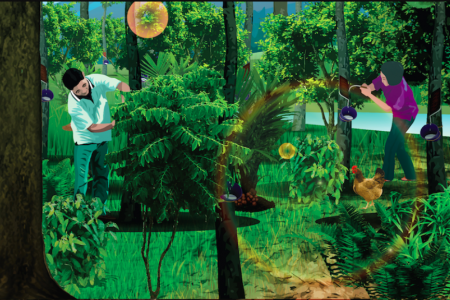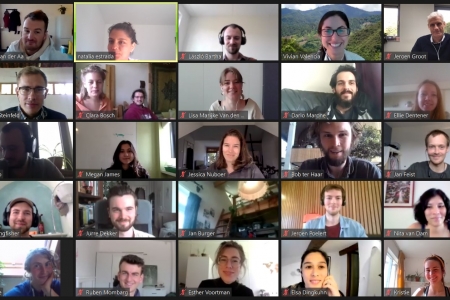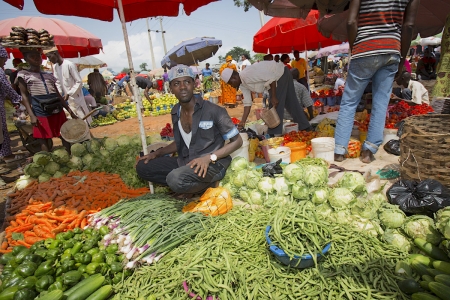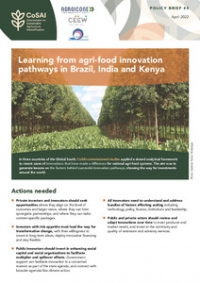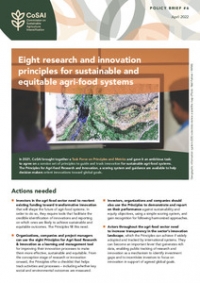This post is part of the “Science on the Pulse” series which highlights the latest in environmental science literature. This months' theme is Ecosystem Services and Resilience.
1. Planetary boundaries: Guiding human development on a changing planet. Steffen, W. et al. Science Express, 15 January 2015.
The highlight of the month is the release of the second paper on planetary boundaries, affectionately known as PBII (disturbing for the Americans amongst us for whom PB refers to peanut butter).
Following the 2009 version led by Johan Rockström, Steffen et al place “biosphere integrity” as one of two core boundaries along with climate change, “each of which has the potential on its own to drive the Earth System into a new state should they be substantially and persistently transgressed”.
Of particular importance to the CGIAR Research Program on Water, Land and Ecosystems (WLE), is the new consideration of scaling regional boundaries to the landscape and basin scale. Water features heavily, with the addition of environmental water flows, a key component of WLE's Managing Resource Variability research theme. Closely related are the biogeochemical systems, particularly nitrogen (N) and phosphorous (P) where the impacts of agriculture are critical drivers. The authors highlight that “a few agricultural regions of very high N [and P] application rates are the main contributors to the transgression of this boundary…a redistribution of N [and P] could simultaneously boost global crop production and reduce the transgression of the regional-level boundary.”
2. Safe and just operating spaces for regional social-ecological systems. Dearing, J.A. et al. Global Environmental Change 28:227-238.
Closely related to the PBII work is this paper that highlights Kate Raworth’s conceptualization of the ‘Oxfam Donut’. The donut identifies the safe and just operating space between the environmental ceilings defined in the planetary boundary framework, and the minimum social foundations required for socially just development (inner circle of the donut). Our question is whether ecosystem services are the “dough” of the planetary donut through their capacity to link environment as a means of raising the social foundations required for socially just development. The authors place particular emphasis on agriculture as a means of poverty alleviation, but driver of environmental degradation, as well as ways to address both simultaneously.
3. The biodiversity-dependent ecosystem service debt. Isbell et al., Ecology Letters 18(2): 119-134.
Giants of ecology write this piece on the relationship between the loss of biodiversity and ecosystem services. The authors develop an approach for quantifying ecosystem service debts, and illustrate how habitat destruction could indirectly diminish carbon storage by creating an extinction debt. They estimate that about. 2–21 pentagrams of carbon could be gradually emitted globally in remaining ecosystem fragments because of plant species loss caused by local habitat destruction, even when in small amounts.
4. Rough waters for native Chinese fish. Hulme, P.E.Science Letters 347(6221):484.
Flagging this for our colleagues at World Fish and those working in the Mekong Focal Region. This summary letter highlights the tremendous diversity of freshwater fish in China and the threats caused by the aquaculture of exotic species: "while the economic value of alien aquaculture species provides a strong incentive to their introduction, the loss of wild fisheries and the extinction of endemic species as well as the reduced resilience of freshwater ecosystems should be taken into account in regulations regarding stocking practices.”
See also: China's aquaculture and the world's wild fisheries (Science 347(6218):133-135) for more in depth coverage – including some reference of interest regarding waste reuse that should be of interest to our colleagues in WLE’s Resource Reuse and Reutilization research theme.
5. The Tyranny of Trees in Grassy Biomes. Veldman et al. Science Letters 347(6221):484-485, 30 January 2015.
I confess that one of the disappointing elements of the new PBII is the focus on forests as the main indicator for land system change. Nothing against forests, but I think it could be dangerous to consider forest ecosystems as the main natural systems to provide ecosystem services. Veldman et al support this by stating: “Afforestation of grassy biomes can severely compromise ecosystem services, including hydrology and soil nutrient cycles, and markedly reduce biodiversity…grassy biomes are not formally recognized by the United Nations (UN) Framework Convention on Climate Change, the program for Reducing Emissions from Deforestation and Forest Degradation (REDD+), or the UN Food and Agriculture Organization. This lack of recognition reflects fundamental misperceptions about the ecology, conservation values, locations, and antiquity of the grassy biomes.”
Delegates at the Intergovernmental Panel on Biodiversity and Ecosystem Services (IPBES) also agreed with this, recently changing text in the Land Degradation and Restoration scoping document to recognize the values of non-forest ecosystem services during the 3rd session of the panel in January 2015.
6. Rethinking the Nicaragua Canal. Huete-Perez, J.A. et al. Science 347(6220):355, 23 January 2015.
The question around the impact of large infrastructure projects on ecosystems and the services they provide are of the genre that WLE engages in. Worryingly, the design of the Nicaragua canal has been shrouded in secrecy, making it difficult to foster dialogue around alternate scenarios to mitigate trade-offs.
7. Brazil’s Soy Moratorium. Gibbs, H.K. et al. Science 347(6220):377-378, 23 January 2015.
Thought this would be of general interest: “Brazil's Soy Moratorium (SoyM) was the first voluntary zero-deforestation agreement implemented in the tropics and set the stage for supply-chain governance of other commodities, such as beef and palm oil. In response to pressure from retailers and nongovernmental organizations (NGOs), major soybean traders signed the SoyM, agreeing not to purchase soy grown on lands deforested after July 2006 in the Brazilian Amazon”.
8. Physical and virtual water transfers for regional water stress alleviation in China. Zhao X. et al. PNAS 112(4):1031-1035.
Colleagues from WLE's Managing Resource Variability research theme might find this interesting: The uneven distribution of freshwater resources “drives a significant amount of water flow both physically and virtually across China. Here, we report on our quantification of China’s physical and virtual water flows and associated water stress at the provincial level…The results highlight the need for more emphasis to be placed on water demand management rather than the current focus on supply-oriented management.”
9. Protecting Coffee from Intensification. Aerts, R. et al. Science. 347(6218):139.
Just as maintaining water flows is essential to maintaining many ecosystem services, the same can be said of gene flow and agricultural biodiversity. This letter regarding the expansion of hybrid coffee in Ethiopia highlights the importance of in situ conservation in the centers of origin of globally important crops. “Excessive forest management and the use of locally improved arabica coffee cultivars are threatening the mating system and the genetic resources of wild Coffea arabica…If the worldwide coffee industry plans to use the genetic diversity of the Ethiopian wild coffee to adapt arabica coffee to climate change and emerging pests and diseases, more conservation efforts in the Ethiopian coffee forests are urgently needed.”
10. Soil biota enhance agricultural sustainability by improving crop yield, nutrient uptake and reducing nitrogen leaching losses. Bender, S. F. et al. Journal of Applied Ecology 52(1):228–239.
“Soil biota are a key factor determining resource efficiency in agriculture. The results suggest that applying farming practices, which favor a rich and abundant soil life (e.g. reduced tillage, organic farming, crop rotation), can reduce environmental impacts, enhance crop yield and result in a more sustainable agricultural system”.
Also see:
Find out more about WLE’s participation at the IPBES meeting in Bonn this January or read a full summary by IISD.
That's all for this month, if you have an article or a story to flag, we’d love to include it in our next Science on the pulse series. Please send it to f.declerck@cgiar.org, including a <100 word comment.
Disclaimer: some of the text above is cut and pasted from the abstracts or central text of the paper cited. Quotations are used to highlight this text, in some cases we have made small modification to adjust the text to the informal flow of this summary.




